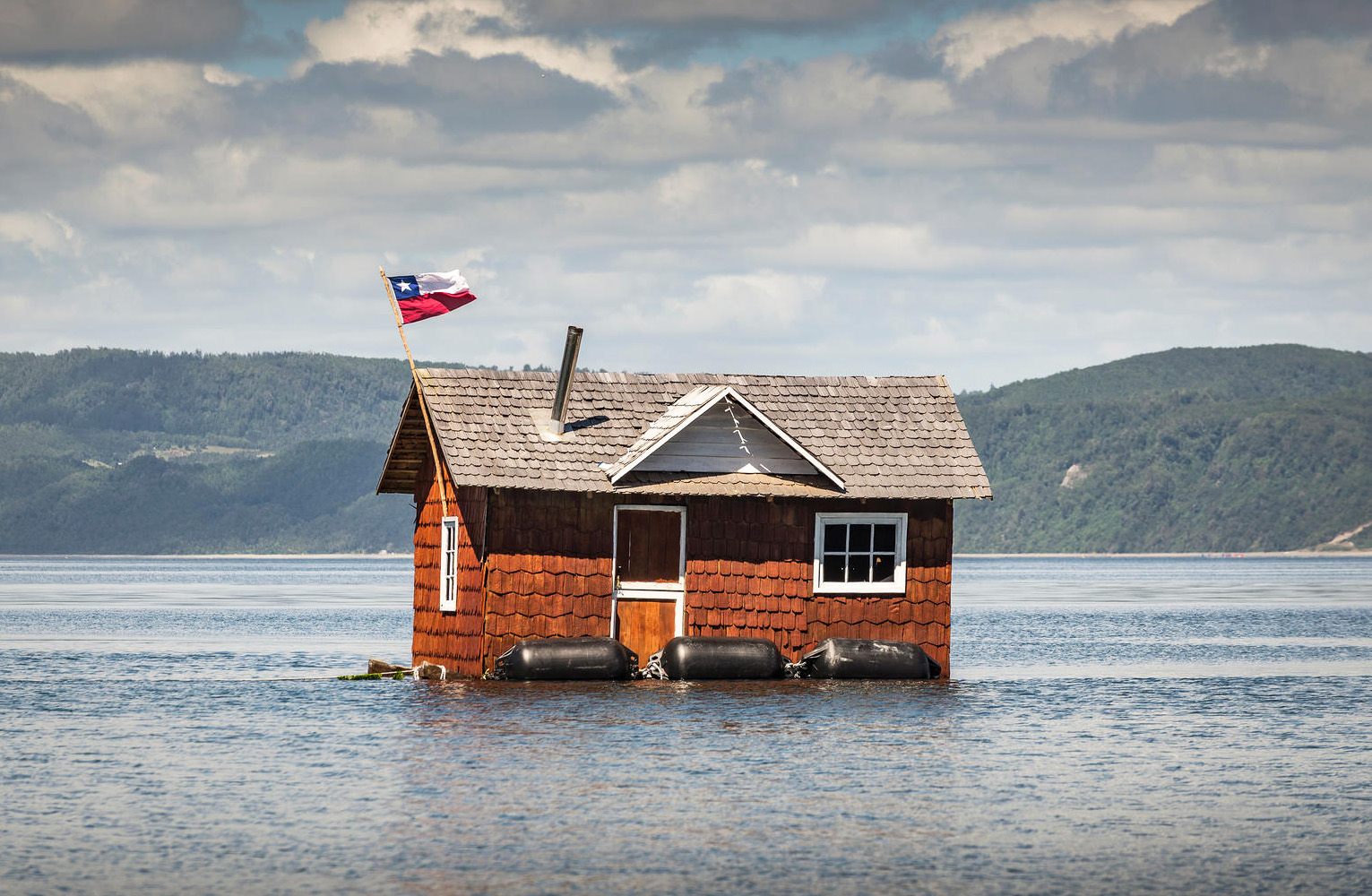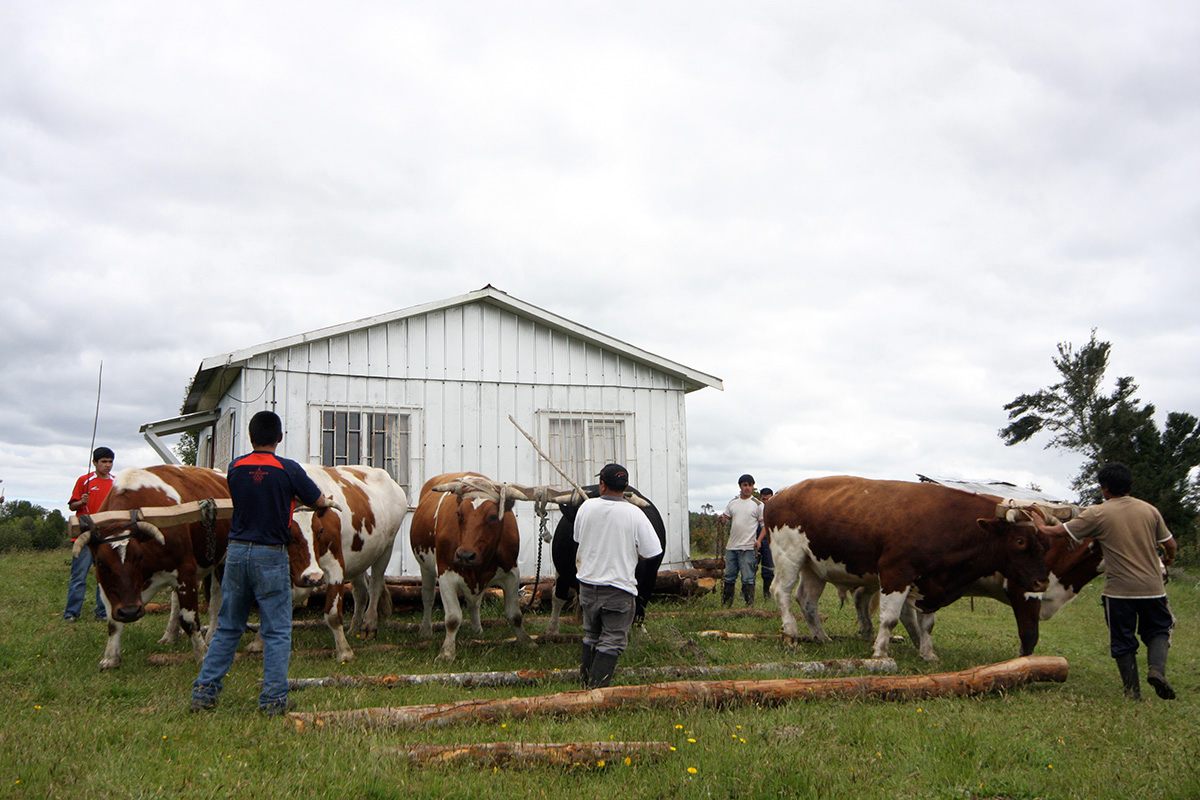On This Chilean Island, the Whole Community Helps Move Your House
The actual building. Sometimes across water.

Moving house can be a real pain. But shuttling some boxes, a couch, and other detritus from point A to point B is small potatoes compared to the ordeal of moving house for the islanders of Chiloé, who physically move their homes from place to place—sometimes over water.
Floating off the coast of southern Chile, the misty archipelago of Chiloé is a pastoral, sheep-dotted, and drizzly, the austral equivalent to Ireland. Verdant forests fringe on undulating fields that roll down to the sea, where palafito stilt houses perch over tidal bays. The ocean provides a constant flow of fresh catches, with the promise of sighting whales, dolphins, and penguins (which are not on the menu). The snowy tips of volcanoes on the mainland pierce the skyline.
Meaning “seagull place” in the indigenous Mapuche* language, Chiloé is isolated from the mainland, with no connecting bridges. The only way on or off is by boat or small airplane. This separation has birthed a distinct way of life that distinguishes Chilotes—as the archipelago’s inhabitants are known—from their onshore brethren. Ask any Chilote, and they will say that they are Chilote first, Chilean second. They are a close-knit island community of farmers, fishermen, and sheep herders. An unsinkable sense of heritage keeps them anchored to their wind- and water-battered islands.

Every once in a while, due to non-arable farmland, the threat of tsunami, the danger of erosion, or the rising tides, Chilotes need to move house. And when they do, their house comes with them. It’s a real show, and it’s known as a minga.
Translating to “a meeting of neighbors and friends to do some free work for the community,” a Chilote minga can refer to a range of communal events, such as a gathering for harvest, but is most famous as a house-moving ceremony. These actions are done without payment, but with the expectation of reciprocity in the future should it be needed.
“The minga is a collective work where a community comes together to help each other, and the concepts of solidarity and brotherhood are the pillars of this action,” says Maria Teolinda Higueras, head of the Quemchi Public Library in Chiloé. “What matters is that the neighbor achieves his objective, and that payment is not necessary.”
The custom of mingas started before the Spanish arrived in Chiloé in the 1500s, and is believed to have been brought to the islands by the Huilliche tribe, who learned the practice of communal work without pay from the Incas. The minga was then adopted and used by the Spaniards.
Higueras says modern mingas originated in the 1950s, with the creation of roads on the island.

“Before that time, all the work of the inhabitants of the archipelago of Chile was done by sea, since there were no roads between the villages, therefore all the communities were located by the edge of the ocean. When the roads began to be built in the late 1950s, Chilotes started moving their houses to places where it would be easier to connect them to the roads … thus was created the collective work of the house-moving mingas.”
The need for farmers to gain better access to roads also opened up the possibility of relocating to more fertile ground. For low-income families surviving on the slim and volatile profits of farming or fishing, leaving behind a perfectly good house only to have to invest the time and money in building a new one elsewhere is not the most feasible option. Besides, with a whole community at their disposal to help with the move, who needs to pay general contractor fees?
For many Chilotes, the tradition is also rooted in their spiritual beliefs. Although Chiloé’s main religion is Catholic, the islands are also rich in pre-Christian pagan mythology, involving apparitions such as El Caleuche, a local ghost ship staffed by drowned fishermen. It is also believed that the “collective Chilote spirit” resides within the home, so leaving one’s home for a new one would be to abandon a vital part of their cultural identity. Many Chilotes still believe in the myths, which is why sometimes a minga’s purpose is to move a house away from haunted land.
The preparations for the minga take several days, with the family first going to their town to ask for assistance and establishing an official date for the move. The house is then prepped for departure, with furniture, windows, and doors either removed or secured in place. Sometimes, the building is reinforced with struts so it doesn’t suffer structural damage en route.
The big day arrives. After the house is blessed for the journey, it is removed from its wooden foundations and hoisted onto tree-trunk rollers. A team of oxen or bulls is hooked up, and the helpers (usually men) drive the oxen forward, with the “minga engineer” overseeing the procession. Men outside the house help direct the oxen and adjust the rollers, while men inside the house spur the oxen forward with sticks and shouts. The minga route is usually lined with other villagers and onlookers cheering them on.

Moving a house overland is laborious enough, but water-crossing mingas take things up a notch.
Having been pulled to the beach, the house is deposited below the waterline at low tide to wait for the tide to come in, and buoys are attached to the underside of the structure. As Chilote houses are single-story and wooden, they are generally light enough to be towed across channels without completely submerging. Some houses can also be placed on a small raft to help them float.
Once the tide is in and the house is surrounded by water, it’s hooked up to one or more boats, and is pulled at a steady speed through the water to its destination. The house is then floated as close to shore as possible at low tide, refitted to a new team of oxen, and is pulled back onto the wooden rollers to finish the journey.
It can take several days, but when the minga is finally completed and the house safely returned to dry ground, the community celebrates. Curanto, a clambake-style meal of seafood, meat, and potatoes, is prepared by the family for the workers and community. With music and drink, everyone dances and parties as the house is, once again, blessed.

“Moving the house is a sensation of joy, of happiness, because we achieve the goal with the whole community,” says Higueras.
Because of their rarity and spectacle, mingas nowadays are a big attraction, drawing tourists and other locals to watch the procession and take part in the afterparty. Some, like Higueras, believe this is a slippery slope.
“The threat is that mingas will become arranged for the expectation of the tourists, without a larger objective than that … mingas should not be an instrument to develop tourism,” she says. “It is a reason to attract tourists to the area and while we do not oppose that, it would be a real shame to have mingas without having the need for their original purpose.”

With plans to finally construct a bridge connecting the island to the mainland, tourism becoming a greater economic force and incentive, and climate change a looming threat to coastal communities, change is in the winds in Chiloé.
But based on Chilotes’ proven adaptability, molding centuries-old traditions to suit modern necessities, whatever comes will be handled hand-in-hand with neighbors and communities. When houses float, anything’s possible.
*Correction: The article originally stated that the name Chiloé comes from the indigenous Quechua language. It comes from the Mapuche language.













Follow us on Twitter to get the latest on the world's hidden wonders.
Like us on Facebook to get the latest on the world's hidden wonders.
Follow us on Twitter Like us on Facebook